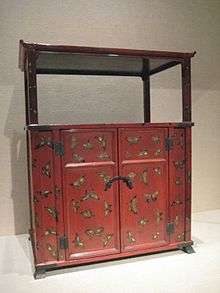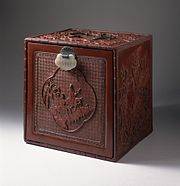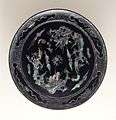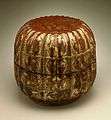Ryukyuan lacquerware
Ryukyuan lacquerware is one of the chief artistic products of the Ryukyu Islands (today Okinawa Prefecture of Japan), and represents a form and style of lacquerware which is distinct from that of the surrounding cultures. Though distinct in its own ways, it is strongly influenced by Chinese, Japanese, and Southeast Asian modes.
.jpg)
Ryukyuan lacquerware is distinguished by the use of inlaid seashells and various native Ryukyuan artistic motifs, and a strong tendency towards red lacquer, which is rather less common in the rest of Japan.
History
As the lacquer tree is not native to Okinawa, the key material needed to produce lacquerware could only be obtained by the Ryukyuans through trade. Though the islands were involved with trade with Japan and the Asian mainland for many centuries, it is generally believed that the presence and production of lacquerware in Ryukyu only began to any significant extent in the late 14th or early 15th centuries.
An office to supervise lacquerware craftsmen was established as Kaizuri bugyōsho (貝摺奉行所).[1] According to "Ryūkyūkoku yuraiki (琉球国由来記)", or the Official Chorography of Ryūkyū published in 1713, it was during 17th century that Kaizuribugyōsho focused on introducing technology from China and Satsuma.[2] Since 1686 entries of lacquer trees cultivation as well as harvest of lacquer juice was recorded in Kishaba Monjo (喜舎場文書), with evidence on mairi tsukawashijō.[3] Thus the Ryūkyū government managed and encouraged lacquerware production from lacquer juice harvest[4][5] It was during 1800s when Kaizuri Bugyōsho supervised export of Ryukyuan lacquerware with tsuishu suikin techniques.[6]
Formal tributary relations with China began in 1372, and in 1427, the Xuande Emperor famously bestowed upon Hashi, King of Ryukyu, the honorary family name Shō (Shang), along with a lacquer tablet inscribed with the characters for Chūzan, and a number of other lavish gifts, including lacquerwares and formal court robes. This famous lacquer tablet was installed over the entrance to Shuri Castle, where it remained until the mid-20th century.
Ryukyu enjoyed a booming trade with Southeast Asia and Korea, and traded many goods from these countries with China, either as tributary gifts or as regular trade goods. Beginning in 1609, when Ryukyu was invaded by Japan's Satsuma Domain, its trade with Southeast Asia and Korea all but came to an end, replaced by commerce with Satsuma. For roughly five hundred years, from 1372 until the mid-19th century, a small number of Ryukyuans resided in Fuzhou and Beijing at any given time, studying academic classics and various arts as well. The community of scholars in Kumemura, on Okinawa, also included a number of skilled artists and craftsmen. Thus, given the changes in Ryukyu's relationships with foreign countries over its history, it is easy to see why Ryukyuan lacquer prior to the 17th century shows strong Chinese, Korean and Southeast Asian influences, while objects produced after the Japanese invasion evidence far stronger Japanese influences.
Developments of the 1860s–70s, chiefly results of the Meiji Restoration, brought the end of the feudal system, and of tributary relations to both China and Satsuma. Thus, the state monopoly on foreign trade similarly came to an end, and regular Japanese citizens were given the opportunity to purchase Ryukyuan lacquers for the first time. A national industrial promotion exposition in Tokyo in 1881 provided, for many people, their first exposure to Ryukyuan arts.
Following World War II and the extensive destruction incurred in the islands during the battle of Okinawa, a number of surveys have been undertaken to learn more about Ryukyuan lacquer (and a great many other cultural and historical subjects), and to discover and collect objects displaced during and following that struggle.
Motifs and style

Ryukyuan lacquer, like lacquerwares from other parts of East and Southeast Asia, comes in a number of standard categories: painted lacquer, carved, incised and filled in with gold, painted with gold, and inlaid with mother-of-pearl. The use of mother-of-pearl in particular is a common feature of Ryukyuan lacquers, as is the use of particular shades of red, especially as a background. However, it is generally said that the primary distinguishing feature of Ryukyuan lacquers is simply that they "appear to be neither purely Chinese on the one hand nor purely Japanese on the other."[7]
The distinctive red color often seen in Ryukyuan lacquer is of a "deeper, more vibrant tone than that from China or ... Japan".[8] It is obtained by mixing raw lacquer with red pigment in roughly equal amounts, a mixture which turns blood-red in the sunlight.
Though the styles and techniques of producing lacquerware were originally introduced to Ryukyu by China, native motifs gradually came to be incorporated into the islands' lacquerwares. Mother-of-pearl inlay is similarly not originally a Ryukyuan element, but it came to be used to depict papaya, plantain, palm trees, tomoe, and other motifs of the sub-tropical islands. Other designs, such as images of hibiscus and coral, were introduced in the latter half of the 20th century as part of the artificial cultural production of tourism goods. Traditionally, the use of yellow, green, and other colored lacquers to create designs against the red background is another distinctive Ryukyuan method.
Finally, there is a technique known as tsuikin which is especially distinctive for Ryukyuan lacquers. Lacquer is mixed with pigments to create a sort of clay or putty, which is shaped and carved and then applied onto the object, in order to create textured three-dimensional effects.
Despite these decorative particularities, the basic process of producing lacquerwares differs little between Ryukyu, Japan, and the mainland of Asia. However, Ryukyu does enjoy a number of native woods growing on its islands, including that of the deigo coral tree (Erythrina variegata). Some traditional processes also involve the use of raw pig's blood or sea sands as part of the undercoat.
 Chest with cartouche, about 1750–1800
Chest with cartouche, about 1750–1800 Dish with mother-of-pearl inlay, about 1700–1800
Dish with mother-of-pearl inlay, about 1700–1800 Footed tray, about 1700–1800
Footed tray, about 1700–1800 Foliated box, about 1750–1850
Foliated box, about 1750–1850- Food box, 18th century
References
- "貝摺奉行所跡". Naha City Museum of History. Retrieved 2016-01-20.CS1 maint: ref=harv (link)The office was known to be relocated in 1745 to the vicinitiy of present day Shuri Castle.
- 『琉球の漆について(林学科)』Nakama, Yūei (1981). Ryūkyū no urushi nituite- ringakuka (Ryukyu lacquarware) (in Japanese). 琉球大学農学部.CS1 maint: ref=harv (link)
- "mairi tsukawashijō (参遣状)" was a correspondence between Ryūkyū government and officials on Yaeyama islands. Shishi Henshūshitsu, ed. (1995). "Mairitsukawashijō nukigaki". Ishigaki shishi sōsho. Okinawa, Japan: Ishigaki-shi. Retrieved 2015-01-20.CS1 maint: ref=harv (link)
- 『沖縄県立博物館紀要』Ono, Masako. "Yaeyamano urushi nituite (Yaeyama Lacquerware)". Okinawa kenritsu hakubutsukan kiyō (in Japanese). Naha, Okinawa: Okinawakenritsuhakubutsukan.
- "Exhibition: Ryukyuan Lacquer" (PDF). Okinawa kenritsu hakubutsukan-dayori. 16: 2. 1983.CS1 maint: ref=harv (link)
- 沖縄県立芸術大学紀要『沈金と堆錦技法の琉球漆器 : 朱漆鳳風牡丹文沈金東道盆 (とぅんだーぶん) と黒漆山水文堆錦総張文庫Aguni, Kyoko (2007-03-31). "Ryukyuan Lacquer-Art Works : The chinkin and tsuikin technique (Introduction of The Arts Museum Collection)". Bulletin, Okinawa Prefectural University of Arts (in Japanese). Okinawa Prefectural University of Arts. 15 (VI).
- Garner, Harry (1972). Ryūkyū Lacquer. London: Percival David Foundation of Chinese Art. p. 12.
- Inumaru, Tadashi; Yoshida, Mitsukuni, eds. (1992). The Traditional Crafts of Japan 4: Lacquerware. Tokyo: Diamond. p. 136.